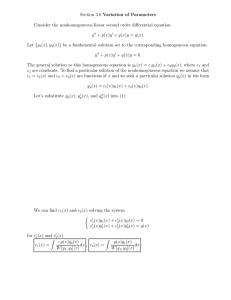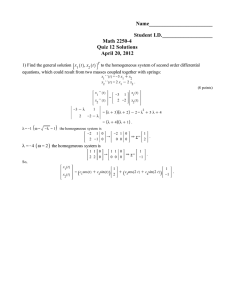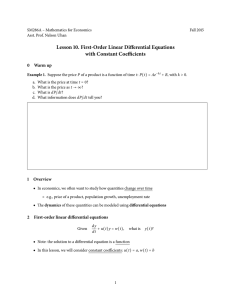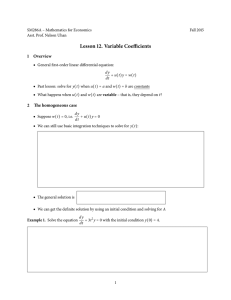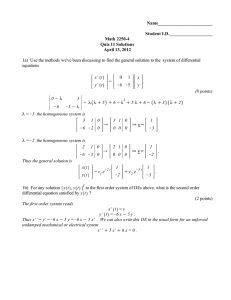Math 230 - Mathematical Notation
advertisement
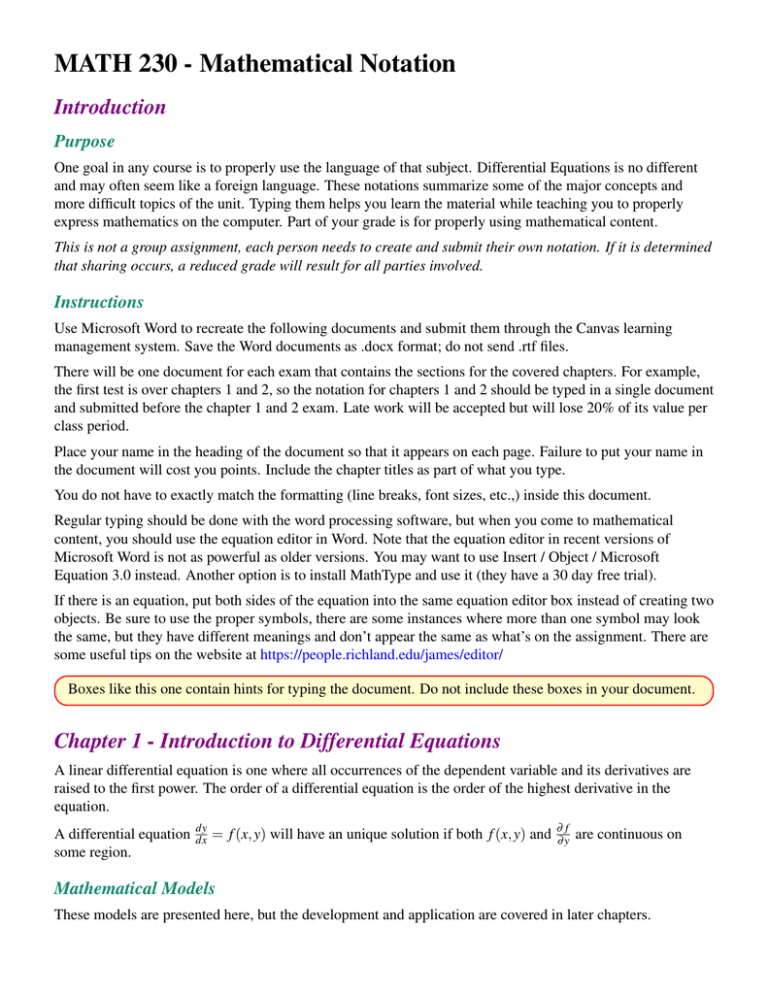
MATH 230 - Mathematical Notation
Introduction
Purpose
One goal in any course is to properly use the language of that subject. Differential Equations is no different
and may often seem like a foreign language. These notations summarize some of the major concepts and
more difficult topics of the unit. Typing them helps you learn the material while teaching you to properly
express mathematics on the computer. Part of your grade is for properly using mathematical content.
This is not a group assignment, each person needs to create and submit their own notation. If it is determined
that sharing occurs, a reduced grade will result for all parties involved.
Instructions
Use Microsoft Word to recreate the following documents and submit them through the Canvas learning
management system. Save the Word documents as .docx format; do not send .rtf files.
There will be one document for each exam that contains the sections for the covered chapters. For example,
the first test is over chapters 1 and 2, so the notation for chapters 1 and 2 should be typed in a single document
and submitted before the chapter 1 and 2 exam. Late work will be accepted but will lose 20% of its value per
class period.
Place your name in the heading of the document so that it appears on each page. Failure to put your name in
the document will cost you points. Include the chapter titles as part of what you type.
You do not have to exactly match the formatting (line breaks, font sizes, etc.,) inside this document.
Regular typing should be done with the word processing software, but when you come to mathematical
content, you should use the equation editor in Word. Note that the equation editor in recent versions of
Microsoft Word is not as powerful as older versions. You may want to use Insert / Object / Microsoft
Equation 3.0 instead. Another option is to install MathType and use it (they have a 30 day free trial).
If there is an equation, put both sides of the equation into the same equation editor box instead of creating two
objects. Be sure to use the proper symbols, there are some instances where more than one symbol may look
the same, but they have different meanings and don’t appear the same as what’s on the assignment. There are
some useful tips on the website at https://people.richland.edu/james/editor/
Boxes like this one contain hints for typing the document. Do not include these boxes in your document.
Chapter 1 - Introduction to Differential Equations
A linear differential equation is one where all occurrences of the dependent variable and its derivatives are
raised to the first power. The order of a differential equation is the order of the highest derivative in the
equation.
A differential equation
some region.
dy
dx
= f (x, y) will have an unique solution if both f (x, y) and
∂f
∂y
are continuous on
Mathematical Models
These models are presented here, but the development and application are covered in later chapters.
First-Order Linear Models
Population Dynamics: The rate of population growth is proportional to the total population at that time.
dP
dt = kP.
Radioactive Decay: The rate at which the nuclei of a substance decay is proportional to the number of nuclei
remaining. dA
dt = kA
Newton’s Law of Cooling: The rate at which the temperature of a body changes is proportional to the
difference between the temperature of the body and the surrounding medium. dT
dt = k(T − Tm )
Second-Order Linear Models
2
1
Series Circuits: Kirchhoff’s second law says L ddt 2q + R dq
dt + C q = E(t)
2
Falling Bodies: Without air resistance and a positive upwards direction, m ddt 2s = −mg or m dv
dt = −mg. With
2
d s
ds
air resistance (viscous damping) and a positive downward direction, m dv
dt = mg − kv or m dt 2 + k dt = mg.
Non-Linear Models
Chemical Reactions: The rate at which a reaction proceeds is proportional to the product of the remaining
concentrations. dX
dt = k(α − X)(β − X)
Spread of Disease: The rate at which a disease spreads is jointly proportional to the number of people who
have been exposed and the number of people who haven’t been exposed. dP
dt = kP(L − P)
Chapter 2 - First-Order Differential Equations
A differential equation is autonomous if it is a function of the dependent variable only .
A first-order DE is separable if it can be written in the form
dy
dx
= g(x)h(y).
dy
The standard form for a linear first-order DE is dx
+ P(x)y = f (x) and is homogeneous if f (x) = 0. The
solution to this DE is the sum of two solutions y = yc + y p where yc is the general solution to the
homogeneous DE and y p is the particular solution to the nonhomogeneous
DE. The procedure known as
R
P(x)dx
variation of parameters leads to an integrating factor µ = e
.
For a function z = f (x, y), the differential is dz = ∂∂ xf dx + ∂∂ yf dy. If the function is a constant, then the
differential is 0. A DE of the form M(x, y)dx + N(x, y)dy = 0 is an exact differential equation if the left hand
side is a differential of some function f (x, y). If M and N are continuous and have continuous partial
derivatives on some region, then it is exact
if and only
if Nx = My . If a DE is exact, then you can find the
R
R
potential function f (x, y) by integrating M dx and N dy and collecting the distinct terms.
A function is homogeneous of degree α if it has the property that f (tx,ty) = t α f (x, y). If both M and N are
homogeneous functions of the same degree, then the substitutions y = ux or x = vy will reduce
M dx + N dy = 0 to a separable first-order DE.
Bernoulli’s equation is
dy
dx
+ P(x)y = f (x)yn and can be solved with the substitution u = y1−n .
Use ASLEHBN as a way to remember the order of attacking a first-order DE: Autonomous, Separable,
Linear, Exact, Homogeneous, Bernoulli, or None of these.
Chapter 3 - Modeling with First-Order Differential Equations
Falling Body: The model for a falling body where air resistance is proportional to the velocity is
dv
dt
= g − mk v.
Logistic Equation: When the rate of growth of a population P is proportional to the amount present and the
amount remaining before reaching the carrying capacity L, then the resulting DE is dP
dt = kP(L − P).
Kirchhoff’s Laws
Let E(t) be impressed voltage, i(t) be current, q(t) be charge, L be inductance, R be resistance, and C be
capacitance. Current and charge related by i(t) = dq
dt .
Conservation of Charge (1st law): The sum of the currents entering a node must equal the sum of the
currents exiting a node.
Conservation of Energy (2nd law): The voltages around a closed path in a circuit must sum to zero (voltage
drops are negative, voltage gains are positive).
2
di
= L ddt 2q . The voltage drop across a resistor is iR = R dq
The voltage drop across an inductor is L dt
dt . The
1
voltage drop across a capacitor is C q. The sum of the voltage drops is equal to the impressed voltage
2
1
L ddt 2q + R dq
dt + C q = E(t) .
Chapter 4 - Higher-Order Differential Equations
Superposition Principle - Homogeneous Equations: A linear combination of solutions to a homogeneous
DE is also a solution. This means that constant multiples of a solution to a homogeneous DE are also
solutions and the trivial solution y = 0 is always a solution to a homogeneous DE.
A set of functions is linearly dependent if there is some linear combination of the functions that is zero for
every x in the interval.
A set of solutions is linearly independent if and only if the Wronskian is not zero for every x in some interval.
A set of linearly independent solutions to a homogeneous DE is said to be a fundamental set of solutions and
there is always a fundamental set for a homogeneous DE.
y1
y
·
·
·
y
n
2
0
0
y0
y2
···
yn 1
The Wronskian of n functions y1 , y2 , . . . , yn , is the n × n determinant W = ..
..
.. ...
.
.
. (n−1) (n−1)
(n−1) y
y2
· · · yn
1
Any function free of arbitrary parameters that satisfies a nonhomogeneous DE is a particular solution, y p . The
complementary function, yc , is the general solution to the associated homogeneous DE. The general solution
to a nonhomogeneous equation is y = yc + y p .
Reduction of Order: If y1 is a solution to a second-order linear homogeneous DE in standard form
Z −1
R
µ
P(x) dx is the integrating
00
0
dx,
where
µ
=
e
y + P(x)y + Q(x)y = 0, then a second solution is y2 = y1
y21
factor from chapter 2.
Homogeneous Linear Equations with Constant Coefficients: The auxiliary equation is formed by
converting the DE into a polynomial function. For example, 3y(5) + y(4) + 3y000 + 109y00 + 192y0 + 52y = 0
would have an auxiliary equation of 3m5 + m4 + 3m3 + 109m2 + 192m + 52 = 0. You find the solutions to the
auxiliary equation, which in this case are m = −2 with multiplicity 2, m = − 31 , and m = 2 ± 3i. From each of
the roots, we form a linear independent combination of terms involving emx . Thus
y = c1 e−2x + c2 xe−2x + c3 e−1/3 x + e2x (c4 cos 3x + c5 sin 3x).
Two common DEs y00 + k2 y = 0 and y00 − k2 y = 0 have solutions of y = c1 cos kx + c2 sin kx and
y = c1 ekx + c2 e−kx respectively. The solutions to y00 − k2 y = 0 can also be written as y = c1 cosh kx + c2 sinh kx.
Method of Undetermined Coefficients - Superposition Approach: This method is useful when the
coefficients of the DE are constants and the input function is comprised of sums or products of constant,
polynomial, exponential, or trigonometric (sine and cosine) functions. You make guesses about the particular
solutions based on the form of the input and then equate coefficients.
Method of Undetermined Coefficients - Annihilator Approach: L is an annihilator of a function if it has
constant coefficients and L ( f (x)) = 0.
• Use Dn to annihilate functions of the form xk , where k is a whole number less than n.
• Use D − α to annihilate functions of the form eαx .
• Use D2 + β 2 to annihilate functions for the form cos β x or sin β x.
• Combinations
of polynomial, exponential, and trigonometric functions can be annihilated by using
n
(D − α)2 + β 2 that annihilates functions of the form xk eαx cos β x or xk eαx sin β x, where k is a whole
number less than n.
Variation of Parameters: Variation of parameters can be used when the coefficients of the DE are not
constants. It involves the Wronskian, W , and two functions u01 = − y2Wf (x) and u02 = y1Wf (x) that are integrated to
find u1 and u2 . The particular solution is then y p = u1 y1 + u2 y2 .
Cauchy-Euler Equation: This looks like a linear DE with constant coefficients except that the coefficients
have an extra factor of xk , where k is the same as the order of the derivative. The solution is y = xm , which
makes y0 = mxm−1 , y00 = m(m − 1)xm−2 , and so on. Substitute and solve for m, but then replace x by ln x when
writing the solution. For example, x2 y00 + 5xy0 + 4y = 0 turns into m(m − 1) + 5m + 4 = 0, which has a
solution of m = −2 with multiplicity 2. The solution is y = c1 e−2 ln x + c2 (ln x)e−2 ln x , which simplifies to
y = c1 x−2 + c2 x−2 ln x.
Chapter 5 - Modeling with Higher-Order Differential Equations
Spring/Mass Systems
Let x = 0 be the equilibrium position with downward being the positive direction.
The main equation is mẍ + β ẋ + kx = f (t). Dividing through by the mass, m, and making some substitutions
β
, ω 2 = mk , and F(t) = f m(t) .
gives us ẍ + 2λ ẋ + ω 2 x = F(t), where 2λ = m
This is a second order linear differential equation with constant coefficients and can be solved using the
techniques from chapter 4.
Free motion means that no outside forces act on the system, so f (t) = 0 and you have a homogeneous
equation. A driven system means that an external force acts on the system and you have f (t) 6= 0, which
makes it a non-homogeneous equation.
An undamped system means that there are no retarding forces acting on the spring. In this case the first order
term disappears since β = 0. A damped system the medium through which the spring moves slows it down
and β > 0.
We can use d = λ 2 − ω 2 to determine the type of damping in the system. A system is overdamped when
d > 0, underdamped when d < 0, and critically damped when d = 0. If this sounds like determining the types
of roots of a quadratic equation, that’s because it is. The discriminant b2 − 4ac from the general quadratic
equation becomes 2d in these systems.
Series Circuit Analogue
2
1
Kirchhoff’s second law L ddt 2q + R dq
dt + C q = E(t) is a second order, non-homogeneous, linear differential
equation with constant coefficients. It is overdamped, critically damped, or underdamped depending on the
value of the discriminant R2 − 4L
C.
Deflection of a Beam
4
d y
Deflection of a horizontal beam satisfies the equation EI dx
4 = w(x) where EI is the flexural rigidity and w(x)
is the load per unit length.
• An embedded end has no deflection, y = 0, and is horizontal, y0 = 0.
• A free end has no bend, y00 = 0, and cannot be sheared, y000 = 0.
• A simply supported end has no deflection, y = 0, and no bend, y00 = 0.
Chapter 6 - Series Solutions of Linear Equations
∞
If x = x0 is an ordinary point, then a power series centered at x0 is y =
∑ ck (x − x0)k .
k=0
Method of Frobenius
If x = x0 is a regular singular point then there exists at least one solution of the form
y = (x − x0 )r
∞
∞
k=0
k=0
∑ ck (x − x0)k , which simplifies to y = ∑ ck (x − x0)k+r , where r is a constant to be determined.
Bessel’s Equation of Order v
Bessel’s equation is x2 y00 + xy0 + (α 2 x2 − v2 )y = 0. The solution is y = c1 Jv (αx) + c2 J−v (αx) as long as v is
not an integer. If v is integer then the solution is y = c1 Jv (αx) + c2Yv (αx). Technically, this is a solution to
any Bessel equation, but we prefer Jv and J−v when v is not an integer.
The Modified Bessel Equation is x2 y00 + xy0 − (α 2 x2 + v2 )y = 0. The solution is similar to the Bessel
Equation, except you replace J by I and Y by K.
Legendre’s Equation of Order n
Legendre’s equation is (1 − x2 )y00 − 2xy0 + n(n + 1)y = 0. If n is a non-negative integer, then the solution is a
polynomial Pn (x). The first few solutions are P0 (x) = 1, P1 (x) = x, P2 (x) = 12 (3x2 − 1), P3 (x) = 12 (5x3 − 3x),
and P4 (x) = 81 (35x4 − 30x2 + 3). If n is not a non-negative integer, then the solution is an infinite series.
Chapter 7 - The Laplace Transform
You will have trouble getting the L symbol, so you may use L instead. In Microsoft Word’s equation
editor, you can 1) type \scriptL or 2) change the symbols gallery to Scripts and click on the L symbol.
Let f be a function defined for t ≥ 0. The Laplace transform of f (t) is F(s) = L { f (t)} =
provided this integral converges.
R ∞ −st
f (t)dt,
0 e
Basic Tranforms
Here are the basic Laplace transformations.
• L {t n } =
n!
sn+1
• L {eat } =
1
s−a
• L {sin kt} =
k
s2 +k2
• L {cos kt} =
s
s2 +k2
• L {sinh kt} =
k
s2 −k2
• L {cosh kt} =
s
s2 −k2
Solving Initial Value Problems
Laplace transforms can be used to solve initial value problems about t = 0. One of the huge benefits over
what we did in chapter 4 is that this solves the equation and finds the constants at the same time.
1. Take the Laplace transform, L , of both sides
2. Solve for Y (s)
3. Take the inverse Laplace transform, L −1 , of both sides
Partial Fractions
You will need to use partial fractions for many of the problems in this chapter. When the denominators are
composed of distinct linear factors, you can use the cover-up method. In this method, you cover up a factor
and then substitute the corresponding root into the rest of the expression to get the coefficient over the factor.
This shortcut does not work for repeated roots or quadratic factors. In those cases, you may need to use
undetermined coefficients to find the values.
Chapter 8 - Systems of Linear First-Order DEs
Eigenvalues and Eigenvectors
If X0 = AX is a homogeneous linear first-order system, then the polynomial equation is the characteristic
equation det(A − λ I) = 0 and its solutions are the eigenvalues. We want to write a solution as X = Keλt ,
where K is the associated eigenvector.
The general solution to a homogeneous linear system is X = c1 K1 eλ1t + c2 K2 eλ2t + · · · + cn Kn eλnt
If K is an eigenvector corresponding to the complex eigenvalue λ = α + β i, then let B1 = Re(K) and
B2 = Im(K). The two solutions with real coefficients are X1 = [B1 cos βt − B2 sin βt]eαt and
X2 = [B1 sin βt + B2 cos βt]eαt .
For a nonhomogeneous system, the general solution becomes X = Xc + X p and the method of undetermined
coefficients or variation of parameters can be used to find the particular solution.
Matrix Exponentials
At
At
For a homogeneous system, we can define a matrix exponential
2e so that
3X
= e C is a solution to
t
t
X0 = AX. For any square matrix of size n, eAt = I + At + A2 2!
+ A3 3!
+ · · · , which can be written as
∞
tk
.
eAt = ∑ Ak
k!
k=0
Φ(t) = eAt is a fundamental matrix.
For nonhomogeneous systems, X0 = AX + F(t), the general solution is X = Xc + X p where Xc = φ (t)C and
Z t
X p = Φ(t)
Φ−1 (s)F(s) ds. In practice, Φ−1 (s) = e−As can be found from eAt by substituting t = −s.
t0
Chapter 9 - Numerical Solutions of Ordinary DEs
Euler’s Method
In chapter 2 (and in Calculus II), we had Euler’s Method, which used a sequence of local linear
approximations, f (x + ∆x) ≈ f (x) + ∆y where ∆y was approximated by dy = f 0 (x)∆x, to estimate the next
dy
value in y. Replacing ∆x by h and switching to the multivariable form dx
= f (x, y), we get the formula used.
yn+1 = yn + h · f (xn , yn )
Improved Euler’s Method
This method estimates the next y value in the sequence using Euler’s method, y∗n+1 = yn + h · f (xn , yn ), and
then averages the slopes at the two ends of the interval to find a better approximation for the next y.
yn+1 = yn + 12 h f (xn , yn ) + f (xn+1 , y∗n+1 )
Runge-Kutta Methods
These are generalizations of Euler’s method where the slope f (xn , yn ) is replaced by a weighted average of the
slopes on the interval xn ≤ x ≤ xn+1 . That is, yn+1 = yn + h (w1 k1 + w2 k2 + · · · + wm km ), where the weights w
are chosen so that they agree with a Taylor series of order m.
RK1
The first-order Runge-Kutta method is actually Euler’s method. Choose k1 = f (xn , yn ) and w1 = 1 to get
yn+1 = yn + hk1 .
RK2
The second-order Runge-Kutta method chooses k1 = f (xn , yn ), k2 = f (xn + h, yn + hk1 ), and w1 = w2 =
get the improved Euler’s method where yn+1 = yn + 12 h [k1 + k2 ]
1
2
to
RK4
The fourth-order Runge-Kutta method chooses k1 = f (xn , yn ), k2 = f (xn + 12 h, yn + 12 hk1 ),
k3 = f (xn + 21 h, yn + 12 hk2 ), and k4 = f (xn + h, yn + hk3 ). The weights are w1 = w4 = 16 and w2 = w3 = 31 . The
result is yn+1 = yn + 16 h [k1 + 2k2 + 2k3 + k4 ].

